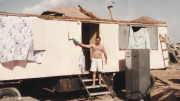In May of 1988, while working for the engineering division of Redpath mining contractors, I was sent to the Golden Patricia mine near Pickle Lake, Ont., for a few weeks to draw up plans for test stoping.
Our crews were extending the main ramp downwards and driving access ways into the ore zone. The first two stope areas were ready to start mining, and our engineers wanted to try various methods of shrinkage, and examine the possibility of long-hole drilling. (As it turned out, the ore zone was too narrow and undulating for long-hole, so we experimented with vertical and horizontal holes drilled with hand-held machines.)
Mike Moore was our contracting superintendent and Steve Scott was our site engineer. Shortly after I arrived, Moore announced that we were ready to take the final round of a ventilation drift driven from the main spiral ramp to break into a previously driven exploration ramp. Someone had to go down and check the bottom of the ramp for miss-holes before the breakthrough round was drilled.
“OK, it’s been a while since we checked the pumps down there. I’ll go and take Dave with me,” Scott said, as he turned to me. “Go get yourself a pair of oiler pants. You are going for the ride of your life!” Little did I know.
Moore gave me a pair of rubberized waterproof trousers, and we drove to the exploration decline portal 2 km away. On the way over, Scott explained that two declines had been driven by previous contractors, and the mine had closed for a couple of years before new owners took over and hired us. The decline was full of ice all winter and was starting to thaw.
We walked into the portal and immediately onto ice. The ice got thicker as we walked, so that even though the roof was going down at a 20% grade, the floor was tilting only slightly downward. A little farther along, the floor got closer to the back, so we had to walk hunched over. Here and there were solid ice pillars averaging about a metre in diameter. The floor was slick from dripping water, which Steve explained was coming from ice pillars behind the walls.
Soon we were crouched down, and I saw we were following a long rope lying on the floor, with knots tied at about 1-metre intervals.
Eventually, the roof got so low that walking was impossible, and Scott said, “Now sit and just push yourself along.” This worked well with the oiler pants, just sliding along and steering to miss the odd pillar. The decline was almost absolutely straight, with only an occasional jog, as required by mining regulations. Eventually, the floor came so close to the back that it was necessary to lie down, put my arms over my head, and slide. At this point, I very much hoped that the previous contractor had not left any rockbolts sticking out.
After several metres of tight conditions, the floor gradually sloped away from the back and pretty soon there was enough room to stand nearly upright again. And eventually, we were walking on gravel, past a couple of sump cutouts containing submersible pumps, until finally we came to a submersible in a pool of water at the face.
All pumps were running as they should, and we verified there were no unblasted bootlegs on the face. Steve explained to me how and where the drift was going to break through, and then we started back up the ramp. When we got onto the wet ice, I appreciated having the knotted rope to use to pull myself along. The tight area wasn’t too difficult to navigate; we just had to worm our way through, with the help of the rope.
The next day our crew drilled and blasted the breakthrough round joining the two ramps, and warm ventilation air began flowing up the old decline to the portal. During the next few weeks, all the ice melted and the long slide was gone. I was one of the last to experience it, and I’ll certainly never forget it.
— The author is a mining technologist based in Yellowknife, N.W.T.




Be the first to comment on "Odds ‘n’ sods: The ride of my life at Golden Patricia"